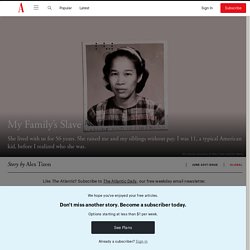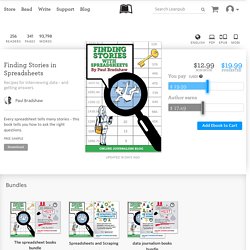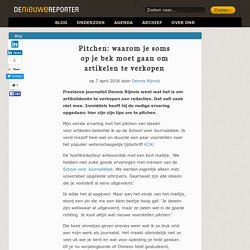

A Story of Slavery in Modern America - The Atlantic. 点击这里阅读中文版本 (Chinese) | Basahin ang artikulong ito sa Tagalog (Tagalog) Alex Tizon passed away in March.

He was a Pulitzer Prize–winning journalist and the author of Big Little Man: In Search of My Asian Self. For more about Alex, please see this editor’s note. The ashes filled a black plastic box about the size of a toaster. It weighed three and a half pounds. Her name was Eudocia Tomas Pulido. Listen to the audio version of this article:Feature stories, read aloud: download the Audm app for your iPhone.
To our American neighbors, we were model immigrants, a poster family. After my mother died of leukemia, in 1999, Lola came to live with me in a small town north of Seattle. At baggage claim in Manila, I unzipped my suitcase to make sure Lola’s ashes were still there. Early the next morning I found a driver, an affable middle-aged man who went by the nickname “Doods,” and we hit the road in his truck, weaving through traffic. The Mystery of Why People Go Missing in Alaska - The Atlantic.
They found what was left of him in the spring of 2014.

Firefighters battling a huge blaze on Alaska’s Kenai Peninsula first spotted a boot in the dirt. Then they noticed some bones scattered across a wide grassy area. Fire crews in Alaska are used to seeing the bones of moose, caribou, bears, and other large creatures that live and die in these woods. So it wasn’t until crew members found a human skull that they stopped to consider that the pieces might go together. The skull was resting on its side, the face angled toward the ground. The Alaska State Troopers arrived by helicopter and salvaged what they could.
The remains were spread across an area about 60 yards in diameter, presumably the work of scavenging animals. Troopers guessed that the bones were those of an adult male, based on the size and style of the boot and the fact that in these circumstances, the deceased is usually a man. Dolly was 53, petite and gregarious, with short black hair, glasses, and an angular face.
Finding Stories in… by Paul Bradshaw. One spreadsheet can tell many stories.

You just have to know the right questions to ask. Based on a decade of training journalists and working with news organisations on data-driven stories, Finding Stories In Spreadsheets outlines the techniques for asking the right questions of data using tools like Excel and Google spreadsheets. These aren't just questions about numbers: you'll find out how spreadsheet techniques can help you find the 'needle in the haystack' in text data.
You'll learn how to clean up and modify your data so that you can ask it different questions, or get it ready for maps or charts, how to create new data from raw materials, and how to combine datasets to look for connections and trends. With regular examples from journalism and real life data to work with, Finding Stories In Spreadsheets is *full* of those questions, in the language that spreadsheets understand. Cover image concept by @CarolineBeavon. Speech To Text & Video Transcription Services. The Journalistic Method: Five Principles for Blending Analysis and Narrative. The intersection of knowledge and narrative, of informed journalism, is the heart of what the Journalist’s Resource project continues to explore.

In the short essay below, Nicholas Lemann, a professor and dean emeritus at the Columbia Journalism School and a longtime staff writer for The New Yorker, articulates a method for journalism that integrates knowledge while preserving the art of storytelling. We reprint it here with his permission: A central problem in the practice of journalism is that most of the time, we are trying to engage in narrative and analysis at the same time. They don’t naturally go together. Journalists more often unwittingly let the narrative distort the analysis than vice versa. Awareness. Nicholas Lemann is the Joseph Pulitzer II and Edith Pulitzer Moore Professor of Journalism and Dean Emeritus at the Columbia University Graduate School of Journalism. Keywords: reporting, style, writing Writer: Journalist's Resource | April 8, 2016. Migratiemythes: fact check. Pitchen: waarom je soms op je bek moet gaan om artikelen te verkopen.
Freelance journalist Dennis Rijnvis weet wat het is om artikelideeën te verkopen aan redacties.

Dat valt vaak niet mee. Inmiddels heeft hij de nodige ervaring opgedaan: hier zijn zijn tips om te pitchen. Mijn eerste ervaring met het pitchen van ideeën voor artikelen beleefde ik op de School voor Journalistiek. Ik vond mezelf heel wat en stuurde een paar voorstellen naar het populair wetenschappelijk tijdschrift KIJK. De hoofdredacteur antwoordde met een kort mailtje. Ik wilde het al opgeven. Die twee zinnetjes geven precies weer wat ik zo leuk vind aan mijn werk als journalist. In de afgelopen jaren heb ik veel ideeën verkocht aan redacties, maar ik ben ook regelmatig op mijn bek gegaan. Stop jezelf niet in de spamfolder Voordat je een redactie overlaadt met ideeën; weet wie je benadert. Zet niet te hoog in Als je nog nooit eerder een artikel hebt gepubliceerd, begin dan niet meteen bij NRC, de Volkskrant of De Correspondent. Leg de nadruk op je ideeën Weet waar je pitcht.